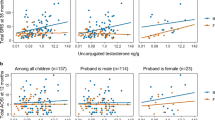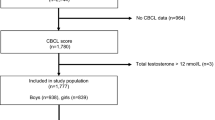Abstract
It is not known whether reproductive factors early in the mother’s life influence risk of autism spectrum disorders (ASD). We assessed maternal age at menarche, menstrual cycle characteristics during adolescence, oral contraceptive use prior to first birth, body shape, and body mass index (BMI) in association with ASD using binomial regression in a cohort study of 61,596 women, including 743 cases. Overall, early life factors were not associated with ASD, though early age at menarche (RR for age 10 or less = 1.54, 95% CI 1.18, 2.02, p = 0.0002) and BMI at age 18 of ≥30 (RR 2.03, 95% CI 1.34, 3.08, p = 0.0008) were significantly associated with increased risk of ASD. Further work should investigate the potential influence of these factors.

Similar content being viewed by others
References
Baer, H., Colditz, G. A., Rosner, B., Michels, K. B., Rich-Edwards, J. W., Hunter, D. J., et al. (2005). Body fatness during childhood and adolescence and incidence of breast cancer in premenopausal women: A prospective cohort study. Breast Cancer Research, 7(3), R314–R325.
Baron-Cohen, S., Lutchmaya, S., & Knickmeyer, R. (2004). Prenatal testosterone in mind. Cambridge: MIT Press.
Bolton, P. F., Murphy, M., MacDonald, H., Whitlock, B., Pickles, A., & Rutter, M. (1997). Obstetric complications in autism: Consequences or causes of the condition? Journal of the American Academy of Child and Adolescent Psychiatry, 36(2), 272–281.
Bos, E. H., Bouhuys, A. L., Geerts, E., Van Os, T. W., Van der Spoel, I. D., Brouwer, W. H., et al. (2005). Cognitive, physiological, and personality correlates of recurrence of depression. Journal of Affective Disorders, 87(2–3), 221–229.
Brimacombe, M., Ming, X., & Lamendola, M. (2007). Prenatal and birth complications in autism. Maternal and Child Health Journal, 11, 73–79.
Carlsen, S., Jacobsen, G., & Romundstad, P. (2006). Maternal testosterone levels during pregnancy are associated with offspring size at birth. European Journal of Endocrinology, 155(2), 365–370.
Carmichael, A. R., & Bates, T. (2004). Obesity and breast cancer: A review of the literature. Breast, 13, 85–92.
CDC. (2006). Mental health in the United States: parental report of diagnosed autism in children aged 4–17 years–United States, 2003–2004. Mmwr. Morbidity and Mortality Weekly Report, 55(17), 481–486.
Chapman, D., & Nam, J. M. (1968). Asymptotic power of chi square tests for linear trends in proportions. Biometrics, 24, 315–327.
Colditz, G. A., Manson, J. E., & Hankinson, S. E. (1997). The Nurses’ Health Study: 20-year contribution to the understanding of health among women. Journal of Womens Health, 6(1), 49–62.
Colditz, G., Martin, P., Stampfer, M. J., Willett, W. C., Sampson, L., Rosner, B., et al. (1986). Validation of questionnaire information on risk factors and disease outcomes in a prospective cohort study of women. American Journal of Epidemiology, 123(5), 894–900.
Durrleman, S., & Simon, R. (1989). Flexible regression models with cubic splines. Statistics in Medicine, 8, 551–561.
Faraone, S. V., Biederman, J., & Milberger, S. (1995). How reliable are maternal reports of their children’s psychopathology? One-year recall of psychiatric diagnoses of ADHD children. Journal of the American Academy of Child and Adolescent Psychiatry, 34(8), 1001–1008.
Feskanich, D., Cho, E., Schaumberg, D. A., Colditz, G. A., & Hankinson, S. E. (2008). Menopausal and reproductive factors and risk of age-related macular degeneration. Archives of Ophthalmology, 126(4), 519–524.
Fombonne, E. (2005). The changing epidemiology of autism. Journal of Applied Research in Intellectual Disabilities, 18, 281–294.
Gardener, H., Spiegelman, D., & Buka, S. (2009). Prenatal risk factors for autism: Comprehensive meta-analysis. The British Journal of Psychiatry, 195, 7–14.
Golub, M., Collman, G. W., Foster, P. M., Kimmel, C. A., Rajpert-De Meyts, E., Reiter, E. O., et al. (2008). Public health implications of altered puberty timing. Pediatrics, 121(Suppl 3), S218–S230.
Govindarajulu, U., Spiegelman, D., Thurston, S. W., Ganguli, B., & Eisen, E. A. (2007). Comparing smoothing techniques in Cox models for exposure-response relationships. Statistics in Medicine, 26(20), 3735–3752.
Harris, M., Prior, J. C., & Koehoorn, M. (2008). Age at menarche in the Canadian population: Secular trends and relationship to adulthood BMI. Journal of Adolescent Health, 43(6), 548–554.
Hines, M. (2006). Prenatal testosterone and gender-related behaviour. European Journal of Endocrinology, 155(Suppl 1), S115–S121.
Juul-Dam, N., Townsend, J., & Courchesne, E. (2001). Prenatal, perinatal, and neonatal factors in autism, pervasive developmental disorder-not otherwise specified, and the general population. Pediatrics, 107(4), E63.
Laitinen, J., Power, C., & Järvelin, M. R. (2001). Family social class, maternal body mass index, childhood body mass index, and age at menarche as predictors of adult obesity. American Journal of Clinical Nutrition, 74(3), 287–294.
Larsson, H. J., Eaton, W. W., Madsen, K. M., Vestergaard, M., Olesen, A. V., Agerbo, E., et al. (2005). Risk factors for autism: perinatal factors, parental psychiatric history, and socioeconomic status. American Journal of Epidemiology, 161(10), 916–925. discussion 926-8.
Lauritsen, M. B., Pedersen, C. B., & Mortensen, P. B. (2005). Effects of familial risk factors and place of birth on the risk of autism: A nationwide register-based study. Journal of Child Psychology and Psychiatry, 46(9), 963–971.
London, E. A., & Etzel, R. A. (2000). The environment as an etiologic factor in autism: A new direction for research. Environmental Health Perspectives, 108 Suppl 3, 401–404.
Lyall, K., Pauls D. L., Santangelo S., Speigelman D., & Ascherio A. (2010). Association between ovulation inducing drug use, infertility, and autism spectrum disorders in the Nurses’ Health Study II. Manuscript submitted for publication.
Lyall, K., Pauls D. L., Speigelman D., Ascherio A., & Santangelo, S. (2009). Pregnancy complications and obstetric suboptimality as risk factors for autism spectrum disorders in children of the Nurses’ Health Study II. Manuscript submitted for publication.
Mather, A., Cox, B. J., Enns, M. W., & Sareen, J. (2009). Associations of obesity with psychiatric disorders and suicidal behaviors in a nationally representative sample. Journal of Psychosomatic Research, 66(4), 277–285.
Mucci, L. A., Lagiou, P., Hsieh, C. C., Tamimi, R., Hellerstein, S., Vatten, L., et al. (2004). A prospective study of pregravid oral contraceptive use in relation to fetal growth. BJOG: An International Journal of Obstetrics and Gynaecology, 111(9), 989–995.
Must, A., Willett, W. C., & Dietz, W. H. (1993). Remote recall of childhood height, weight, and body build by elderly subjects. American Journal of Epidemiology, 138, 56–64.
Rothman, K. J. (1977). Fetal loss, twinning and birth weight after oral contraceptive use. New England Journal of Medicine, 297, 468–471.
Spiegelman, D., & Hertzmark, E. (2005). Easy SAS calculations for risk or prevalence ratios and differences. American Journal of Epidemiology, 162(3), 199–200.
Terry, K., Willett, W. C., Rich-Edwards, J. W., Hunter, D. J., & Michels, K. B. (2005). Menstrual cycle characteristics and incidence of premenopausal breast cancer. Cancer Epidemiology, Biomarkers and Prevention, 14(6), 1509–1513.
Tomeo, C. A., Rich-Edwards, J. W., Michels, K. B., Berkey, C. S., Hunter, D. J., Frazier, A. L., et al. (1999). Reproducibility and validity of maternal recall of pregnancy-related events. Epidemiology, 10(6), 774–777.
Torloni, M., Betrán, A. P., Horta, B. L., Nakamura, M. U., Atallah, A. N., Moron, A. F., et al. (2009). Prepregnancy BMI and the risk of gestational diabetes: A systematic review of the literature with meta-analysis. Obesity Reviews, 10(4), 487–488.
Torrey, E., Hersh, S. P., & McCabe, K. D. (1975). Early childhood psychosis and bleeding during pregnancy. A prospective study of gravid women and their offspring. Journal of Autism and Childhood Schizophrenia, 5(4), 287–297.
Troisi, R., Potischman, N., Roberts, J. M., Harger, G., Markovic, N., Cole, B., et al. (2003). Correlation of serum hormone concentrations in maternal and umbilical cord samples. Cancer Epidemiology, Biomarkers and Prevention, 12(5), 452–456.
Troy, L. M., Hunter, D. J., Manson, J. E., Colditz, G. A., Stampfer, M. J., & Willett, W. C. (1995). The validity of recalled weight among younger women. International Journal of Obesity and Related Metabolic Disorders, 19(8), 570–572.
Tworoger, S., Eliassen, A. H., Missmer, S. A., Baer, H., Rich-Edwards, J., Michels, K. B., et al. (2006). Birthweight and body size throughout life in relation to sex hormones and prolactin concentrations in premenopausal women. Cancer Epidemiology, Biomarkers and Prevention, 15(12), 2494–2501.
van de Beek, C., van Goozen, S. H., Buitelaar, J. K., & Cohen-Kettenis, P. T. (2009). Prenatal sex hormones (maternal and amniotic fluid) and gender-related play behavior in 13-month-old Infants. Archives of Sexual Behavior, 38(1), 6–15.
Vessey, M., Meisler, L., Flavel, R., & Yeates, D. (1979). Outcome of pregnancy in women using different methods of contraception. British Journal of Obstetrics and Gynaecology, 86, 548–556.
Wacholder, S. (1986). Binomial regression in GLIM: Estimating risk ratios and risk differences. American Journal of Epidemiology, 123(1), 174–182.
Wilkerson, D., Volpe, A. G., Dean, R. S., & Titus, J. B. (2002). Perinatal complications as predictors of infantile autism. International Journal of Neuroscience, 112(9), 1085–1098.
Zhang, Y., Graubard, B. I., Longnecker, M. P., Stanczyk, F. Z., Klebanoff, M. A., & McGlynn, K. A. (2007). Maternal hormone levels and perinatal characteristics: Implications for testicular cancer. Annals of Epidemiology, 17(2), 85–92.
Acknowledgments
The Nurses’ Health Study II is an ongoing study conducted at the Channing Laboratory and affiliated with the Brigham and Women’s Hospital, Harvard School of Public Health, and Harvard Medical School. The work reported in this manuscript was funded in part by CA50385, the main Nurses’ Health Study II grant, 1788 from the Autism Speaks Foundation, and A-14917 from the U.S. Army Medical Research and Material Command (USAMRMC). The funding organizations have reviewed and approved the design and conduct of the overall NHS II, but were not involved in the collection, management, analysis, or interpretation of the data; nor were they involved in the preparation, review, or approval of this manuscript.
Conflicts of interest
No conflicts of interest are noted.
Author information
Authors and Affiliations
Corresponding author
Additional information
An erratum to this article can be found at http://dx.doi.org/10.1007/s10803-010-1097-5
Appendix
Appendix
Diagram used for estimating body shape at age 10 
Rights and permissions
About this article
Cite this article
Lyall, K., Pauls, D.L., Santangelo, S. et al. Maternal Early Life Factors Associated with Hormone Levels and the Risk of Having a Child with an Autism Spectrum Disorder in the Nurses Health Study II. J Autism Dev Disord 41, 618–627 (2011). https://doi.org/10.1007/s10803-010-1079-7
Published:
Issue Date:
DOI: https://doi.org/10.1007/s10803-010-1079-7




